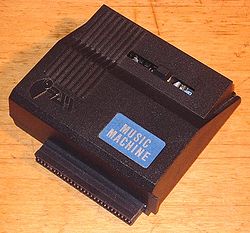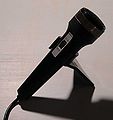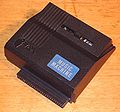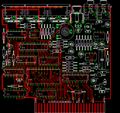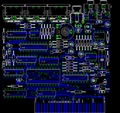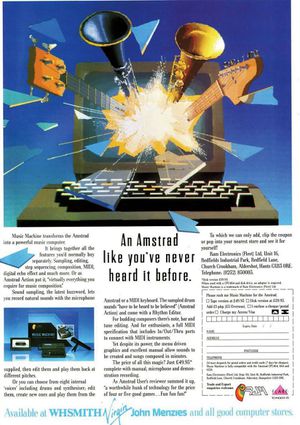Difference between revisions of "Music Machine"
Cpcmaniaco (Talk | contribs) (→Download) |
|||
| (58 intermediate revisions by 12 users not shown) | |||
| Line 1: | Line 1: | ||
| − | [[Image: | + | [[Image:Rammusicmashine.jpg|thumb|right|250px|The Ram Music Machine]] |
| − | + | == Description == | |
| − | + | ||
| − | The Amstrad CPC version | + | A digital sound sampling and playback device. The Music Machine was designed by Flare Technology and manufactured by [[Ram Electronics|RAM Electronics]]. |
| + | |||
| + | The Amstrad CPC version is almost identical to the the ZX Spectrum version, only difference was the address decoding logic. | ||
The Music Machine came with a simple microphone. Recording quality could be improved by using a better(and more expensive) microphone. It came with its own sound sampling software and a sequencer. | The Music Machine came with a simple microphone. Recording quality could be improved by using a better(and more expensive) microphone. It came with its own sound sampling software and a sequencer. | ||
| − | No known emulator supports the Music Machine. | + | No known emulator supports the Music Machine. There was a club advertised through the magazine Sinclare User which sent out a computer tape twice a year full of interesting software developed for the Ram Music Machine. This was contributed to by the members and included thing such as a 128k sampler, fsk syncing mods to the original software and many useful midi tools to name but a few.<br> |
| − | + | ||
The Music Machine was never used for producing sound effects in [[:Category:Demos|Demos]]. | The Music Machine was never used for producing sound effects in [[:Category:Demos|Demos]]. | ||
| − | + | Now, thanks to Jose Leandro, the hardware specialist of the spectrum, with his famous page : | |
| − | + | http://trastero.speccy.org/cosas/JL/JL.htm | |
| − | + | We can know more about this hardware. | |
| − | + | ||
| − | + | == Technical Specifications == | |
| − | + | Information from the manual: | |
| + | The Music Machine incoporates two Ferranti devices for digital-to-analogue (DAC) and analogue-to-digital (ADC) conversion. The part numbers are ZN429E8 and ZN449 respectively. The circuit also include a Motorola [[6850 ACIA chip]] (Asynchronous Communications Interface Adapter) for handling the [[MIDI]] channel, two anti-alias filters (one for input and one for output), a discrete microphone amplifier and a headphone amplifier. The clock signal for the ACIA and the ZN449 is provided by a ceramic oscillator. | ||
| + | |||
| + | The incoming signal from the microphone amplifier is sampled to an 8-bit resolution at a rate of 19.444 thousand samples per second. This yields an analogue bandwidth of approximately 9.5kHz which is in fact the cutoff frequency of the filters. | ||
| + | |||
| + | The clock signal for the ACIA is '''unknown'''. As said above it is based one the same oscillator as used for the ZN449, however, the oscillator is probably ''whatever'' MHz (?) divided by ''whatever'' (?), and its unknown if the ACIA and ZN449 clocks are using the same divider (ie. the ZN449 samples at 19.444kHz, but the ACIA may, or may not, use another frequency). | ||
| + | |||
| + | The Music Machine uses NMI interrupt, but it is not clear exactly what it uses it for. | ||
| + | |||
| + | All of the devices on The Music Machine data bus are accessible to the Amstrad within its I/O space. ACIA transactions must use 16-bit IO instructions; the converters are accesible via 8-bit IO instructions. | ||
{|{{Prettytable|width: 700px; font-size: 2em;}} | {|{{Prettytable|width: 700px; font-size: 2em;}} | ||
| − | |'' | + | | ''Port''||''Direction''||''Name''||''Description'' |
|- | |- | ||
| − | | | + | | F8E8h || Write Only || INTERUPT_SEL |
| + | | Writing 01 to this port disables internal Amstrad interrupts and replaces the IRQ signal from ACIA. Writing 00 restores normality. ''(Unclear how this works exactly - the description sounds as if uses an [[External Interrupt]] (rather than a [[NMI]]), and as if it does somehow disable the CPC's internal 300Hz interrupt?)'' | ||
|- | |- | ||
| − | | | + | | F8ECh || Write only|| ACIA_Control |
| + | | See [[6850 ACIA chip]] for details | ||
|- | |- | ||
| − | | | + | | F8EDh || Write only || ACIA_Data_write |
| + | | See [[6850 ACIA chip]] for details | ||
|- | |- | ||
| − | | | + | | F8EEh || Read only || ACIA_Status |
| + | | See [[6850 ACIA chip]] for details | ||
|- | |- | ||
| − | | | + | | F8EFh || Read only || ACIA_Data_read |
| + | | See [[6850 ACIA chip]] for details | ||
|- | |- | ||
| − | | | + | | F8F0h || Write only || DAC_WRITE |
| + | | Data can written to the DAC via this port | ||
|- | |- | ||
| − | | | + | | F8F4h || Read only || ADC_READ |
| − | |- | + | | The contents of the A-to-D can be read via this port. Note that the A-to-D must have been startet at least 20uS before this port can be read |
| − | + | ||
|- | |- | ||
| + | | F8F8h || Strobe || ADC_START | ||
| + | | Reading or writing to this port will start analogue to digital conversion | ||
|- | |- | ||
|} | |} | ||
| − | == | + | == Pictures == |
| − | + | <gallery> caption="The Music Machine"> | |
| − | + | Image:MusicMachine boxed.JPG| the unit in its box | |
| + | Image:Music machine 1.jpg| | ||
| + | Image:Music machine 2.jpg|missing female connector (?) | ||
| + | Image:Music machine back.jpg|Backside | ||
| + | Image:Music machine microphone 1.jpg|The microphone | ||
| + | Image:Music machine microphone 2.jpg|The microphone | ||
| + | Image:Rammusicmashine.jpg|With female connector | ||
| − | + | </gallery> | |
| − | + | <gallery caption="The Music Machine Layout, thanks to Jose Leandro"> | |
| − | + | File:Music Machine - Delante.jpg|The Music Machine - Front | |
| + | File:Music Machine - Detras.jpg|The Music Machine - Back | ||
| + | File:Music Machine - Conectores.jpg|The Music Machine - Connectors | ||
| + | File:Music Machine - Sin Tapa.jpg|The Music Machine - Without Top | ||
| + | File:Music Machine - PCB Componentes.jpg|The Music Machine - PCB Components | ||
| + | File:Music Machine - PCB Pistas.jpg|The Music Machine - PCB Tracks | ||
| + | File:Music Machine - PCB Front.png|The Music Machine - PCB Front | ||
| + | File:Music Machine - PCB Back.png|The Music Machine - PCB Back | ||
| + | File:Music Machine - Layout.jpg|The Music Machine - Layout | ||
| − | + | </gallery> | |
| − | == | + | == Tape == |
| − | + | <gallery> caption="Music Machine"> | |
| − | + | Image:Music Machine Tape - side B.jpg|Music Machine Tape side B | |
| + | Image:Music Machine Tape - side A.jpg|Music Machine Tape side A | ||
| − | + | </gallery> | |
| − | == | + | == Reviews == |
| − | + | * [[Amstradbladet]] (1987, Issue 9, [[Media:Amstrad Bladet8709022.jpg|Page 22]], and [[Media:Amstrad Bladet8709023.jpg|Page 23]]) (Danish) | |
| − | + | * [[Amstrad Computer User]] (March 1987, [[Media:Amstrad Computer User8703 064.jpg|Page 64]], [[Media:Amstrad Computer User8703 065.jpg|Page 65]], and [[Media:Amstrad Computer User8703 066.jpg|Page 66]]) | |
| − | + | * Review in [[Ε.Π.Τ.Α / Η Ελληνική πλευρά του Amstrad (Greek Side Of Amstrad)]]: | |
| − | + | <gallery caption="Review in Greek Side of Amstrad n.6 (May 1987)"> | |
| − | + | Image:MusicMachine GSOA p1.jpg | |
| − | + | Image:MusicMachine GSOA p2.jpg | |
| − | Image: | + | Image:MusicMachine GSOA p3.jpg |
| − | Image: | + | |
| − | Image: | + | |
</gallery> | </gallery> | ||
| − | == | + | == Advertisements == |
| − | + | [[image:MusicMachine ACU ad 1987.jpg|thumb|none]] | |
| − | + | ||
| − | + | == Datasheets == | |
| − | + | ||
| − | + | * [[Media:MC1458.pdf|Datasheet for MC1458]] {{EN}} {{PDF}} | |
| − | + | * [[Media:MC 6850.pdf|Datasheet for MC6850]] {{EN}} {{PDF}} | |
| − | + | * [[Media:A6850.pdf|Datasheet for ACIA 6850]] {{EN}} {{PDF}} | |
| − | + | * [[Media:1983 Ferranti Data Converters.pdf|Datasheet for Ferranti Data Converters]] {{EN}} {{PDF}} | |
| − | + | * [[Media:ZN448.pdf|Datasheet for Ferranti ZN448/ZN449]] {{EN}} {{PDF}} | |
| − | + | ||
| − | + | == Manual == | |
| − | + | ||
| − | + | * [[Media:Music_Machine_Manual.pdf|Music Machine (RAM Electronics) Manual]] {{EN}} {{PDF}} | |
| − | + | ||
| − | + | == Download == | |
| − | + | ||
| − | + | * [[Media:Music Machine (tape).zip|Music Machine (Tape).zip]] (CDT for Emulators & Exemple on MP3) | |
| − | + | * [[Media:Music Machine (Eagle).zip|Music Machine (Eagle).zip]] (Music Machine files for Eagle) | |
| − | + | ||
| − | + | == Weblinks == | |
| − | + | ||
| − | + | * [http://www.cpc-power.com/index.php?page=detail&num=4329 ''Music Machine'' from CPC-Power] | |
| − | + | * [http://cpcrulez.fr/hardware-audio-music_machine.htm ''Music Machine'' from CPCrulez] | |
| + | * [http://hardware.speccy.org/temp/Amstrad-MusicMachine.html ''Music Machine'' from hardware.speccy.org] | ||
| + | * [http://www.microhobby.com/200903/hard/ram_music_machine.htm ''Music Machine'' from www.microhobby.com] | ||
| + | * [http://www.worldofspectrum.org/hardware/feat17.html Advert for the Music Machine] | ||
| + | * [http://reviews.harmony-central.com/reviews/Keyboard%2FSynth/product/RAM/Music+Machine/10/1 Review] | ||
| + | * [http://www.wacci.org.uk/magazine/136/136_10.html Data transfer via MIDI] | ||
| + | * [http://www.compeng.dit.ie/staff/tscarff/6800/6850acia/6850.htm Information about the Motorola 6850 ACIA] | ||
| − | [[Category: | + | [[Category:Serial interfaces]] [[Category:Peripherals]] [[Category:Music_and_sound]] [[Category:Manual]] |
Latest revision as of 07:55, 11 September 2020
Contents
Description
A digital sound sampling and playback device. The Music Machine was designed by Flare Technology and manufactured by RAM Electronics.
The Amstrad CPC version is almost identical to the the ZX Spectrum version, only difference was the address decoding logic.
The Music Machine came with a simple microphone. Recording quality could be improved by using a better(and more expensive) microphone. It came with its own sound sampling software and a sequencer.
No known emulator supports the Music Machine. There was a club advertised through the magazine Sinclare User which sent out a computer tape twice a year full of interesting software developed for the Ram Music Machine. This was contributed to by the members and included thing such as a 128k sampler, fsk syncing mods to the original software and many useful midi tools to name but a few.
The Music Machine was never used for producing sound effects in Demos.
Now, thanks to Jose Leandro, the hardware specialist of the spectrum, with his famous page :
http://trastero.speccy.org/cosas/JL/JL.htm
We can know more about this hardware.
Technical Specifications
Information from the manual:
The Music Machine incoporates two Ferranti devices for digital-to-analogue (DAC) and analogue-to-digital (ADC) conversion. The part numbers are ZN429E8 and ZN449 respectively. The circuit also include a Motorola 6850 ACIA chip (Asynchronous Communications Interface Adapter) for handling the MIDI channel, two anti-alias filters (one for input and one for output), a discrete microphone amplifier and a headphone amplifier. The clock signal for the ACIA and the ZN449 is provided by a ceramic oscillator.
The incoming signal from the microphone amplifier is sampled to an 8-bit resolution at a rate of 19.444 thousand samples per second. This yields an analogue bandwidth of approximately 9.5kHz which is in fact the cutoff frequency of the filters.
The clock signal for the ACIA is unknown. As said above it is based one the same oscillator as used for the ZN449, however, the oscillator is probably whatever MHz (?) divided by whatever (?), and its unknown if the ACIA and ZN449 clocks are using the same divider (ie. the ZN449 samples at 19.444kHz, but the ACIA may, or may not, use another frequency).
The Music Machine uses NMI interrupt, but it is not clear exactly what it uses it for.
All of the devices on The Music Machine data bus are accessible to the Amstrad within its I/O space. ACIA transactions must use 16-bit IO instructions; the converters are accesible via 8-bit IO instructions.
| Port | Direction | Name | Description |
| F8E8h | Write Only | INTERUPT_SEL | Writing 01 to this port disables internal Amstrad interrupts and replaces the IRQ signal from ACIA. Writing 00 restores normality. (Unclear how this works exactly - the description sounds as if uses an External Interrupt (rather than a NMI), and as if it does somehow disable the CPC's internal 300Hz interrupt?) |
| F8ECh | Write only | ACIA_Control | See 6850 ACIA chip for details |
| F8EDh | Write only | ACIA_Data_write | See 6850 ACIA chip for details |
| F8EEh | Read only | ACIA_Status | See 6850 ACIA chip for details |
| F8EFh | Read only | ACIA_Data_read | See 6850 ACIA chip for details |
| F8F0h | Write only | DAC_WRITE | Data can written to the DAC via this port |
| F8F4h | Read only | ADC_READ | The contents of the A-to-D can be read via this port. Note that the A-to-D must have been startet at least 20uS before this port can be read |
| F8F8h | Strobe | ADC_START | Reading or writing to this port will start analogue to digital conversion |
Pictures
- The Music Machine Layout, thanks to Jose Leandro
Tape
Reviews
- Amstradbladet (1987, Issue 9, Page 22, and Page 23) (Danish)
- Amstrad Computer User (March 1987, Page 64, Page 65, and Page 66)
- Review in Ε.Π.Τ.Α / Η Ελληνική πλευρά του Amstrad (Greek Side Of Amstrad):
- Review in Greek Side of Amstrad n.6 (May 1987)
Advertisements
Datasheets
- Datasheet for MC1458


- Datasheet for MC6850


- Datasheet for ACIA 6850


- Datasheet for Ferranti Data Converters


- Datasheet for Ferranti ZN448/ZN449


Manual
Download
- Music Machine (Tape).zip (CDT for Emulators & Exemple on MP3)
- Music Machine (Eagle).zip (Music Machine files for Eagle)
